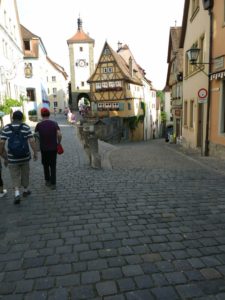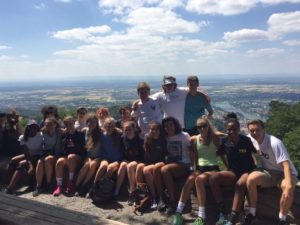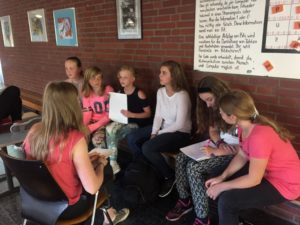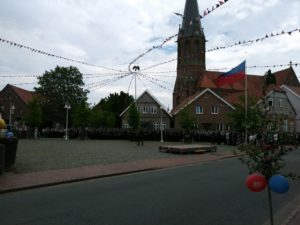
Today we arrived in the city of Rothenburg ob der Tauber. One of the few remaining medieval cities in Germany, Rothenburg’s picturesque houses rest above the surrounding countryside. Although we have only been in the city a few hours, it is easily understandable as to why Rothenburg is one of the most visited cities in all of Germany. The picture attached displays the most photographed site in all of Germany. Everything here is absolutely stunning, we are eagerly awaiting enjoying the city tomorrow.
This evening we participated in a city tour with a Rothenburg night watchman, decked out in full watchman regalia. He explained the history of Rothenburg, which results in the ultimate preservation of this ancient city. I will attempt to briefly summarize this history as follows.
Picking up following the Black Plague, the citizens of Rothenburg fell under attack by enemies of the city who had been conquering and massacring throughout Germany in the 30 Years War. The city decided to hold out against the Catholic invaders, and bravely did so for three days. On the third day, the city ran low on gunpowder. When a soldier was sent to the dark arms hold to check the stores, his torch presumably lit the few remaining casks of powder. This explosion destroyed a major part of the city’s defenses, allowing the invaders entrance. For a few weeks or months prior, the city was occupied by the Catholic soldiers until they left, and the 30 Years War came to an end. Fortunately for the preservation of the city, all of Rothenburg was left in extreme poverty. Due to such poverty, no cultural or economic changes developed in the city. The wall surrounding the city resultingly was left in tact, and the stone was not used for other purposes. For over two hundred years, Rothenburg was left alone. It wasn’t until the Romantics in the 19th century that the city began to gain more attention. Slowly, tourism fueled Rothenburg into a wealthy state once more.
Fast forward a hundred years, and the beginning of World War II began to affect the city. The Jewish citizens were forced from the city, and the Nazis prized Rothenburg for its German beauty. As the war progressed, Allied bombers struck the northern part of the city. Had the day of bombing not been foggy, much more of the city would have been destroyed. As the war drew to a close, German soldiers were ordered to occupy Rothenburg, and not give it up no matter what. American forces prepared to attack the city. At the last minute, the commander of the assault received a phone call, direct from a government official back in the states. The official had heard of the medieval city from his mother, who had come to Rothenburg in 1914. From the stories told by his mother, the official decided the city should be spared. Fortunately, the commanding German officer was out of town when the Americans attempted to reach peaceful agreements just outside the city walls. The remaining German officer saw the war coming to a close, and happily forfeited the city. American troops occupied Rothenburg the following day. Later, the US official who called of the assault was awarded honorary citizenship.
Rothenburg had been largely spared, however, the city still faced financial problems, not to mention the destroyed northern part of the city. Thus, Rothenburg opened to the world, inviting everyone to symbolically purchase parts of the wall. The funds of this project helped immensely in the reconstruction and modernization of Rothenburg. All of the donors to the city received plaques of commemeration, which are still visible when walking the city walls.
Rothenburg’s history is complex, yet also incredibly lucky. Had the perfect string of events not occurred, this pearl in the German countryside could have been permanently lost. Today we spend the whole day in Rothenburg, and are looking forward to seeing what else the city offers.
~ Hans Christoffersen













